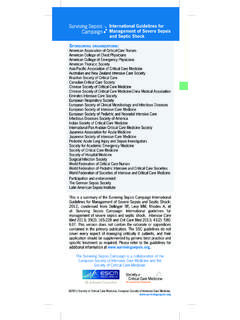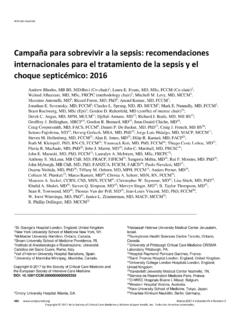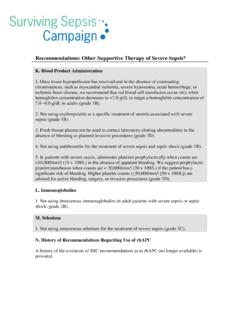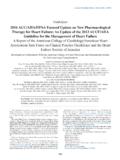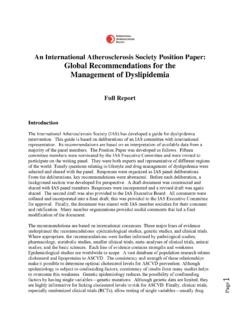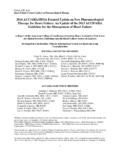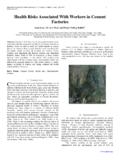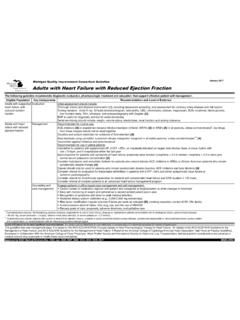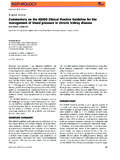Transcription of Stony Brook Medicine Severe Sepsis/Septic Shock ...
1 1 Stony Brook Medicine Severe Sepsis/Septic Shock recognition and Treatment Protocols Subject: Severe Sepsis/Septic Shock Published Date: August 9, 2013 Scope: Hospital Wide Original Creation Date: August 9, 2013 Protocol: The institution of evidence-based early recognition and invasive/non-invasive treatment guidelines for Severe sepsis and septic Shock through active surveillance screening, via both electronic and staff observation tools, regarding patients presenting on admission through our Emergency Department and those developing nosocomial infections or suspected infections within our inpatient units at Stony Brook University Medical Center. Treatment guidelines follow those recommended by the Surviving sepsis Campaign, a workgroup of the Society for Critical Care Medicine and the European Society of Intensive Care Medicine and are updated accordingly. Pediatric protocols are also consistent with American College of Critical Care Medicine guidelines.
2 Stony Brook University Hospital is a level 3 tertiary care hospital. All patients are treated on-site as we provide the highest level of care. Definitions: Surviving sepsis Campaign: An international collaborative recommending resuscitation and management care bundles for the recognition and treatment of Severe Sepsis/Septic Shock . Recommendations were first published as in Critical Care Medicine , Mar 2004. SIRS (Systemic inflammatory response syndrome): The clinical syndrome that results from a deregulated inflammatory response or to a noninfectious insult. sepsis : SIRS that is secondary to infection that has been diagnosed clinically. Positive cultures add to the validity but are not required for the diagnosis. Severe sepsis : sepsis plus at least one sign of hypoperfusion or organ dysfunction (see below), that is new, and not explained by other known etiology of organ dysfunction. septic Shock : Severe sepsis associated with refractory hypotension (BP<90/60) despite adequate fluid resuscitation and/or a serum lactate level >= mmol/L.
3 Rapid Response Team: A team of qualified clinicians that respond to a perceived change in, or deterioration of, the condition of patients by bringing critical care expertise to the bedside. Presentation Time: Initial time of recognition of Severe sepsis (SIRS and organ dysfunction). Emergency Department presentation is judged to be a patient s triage time unless clinically evidenced otherwise. All other presentations rely on a time at which signs, symptoms, and laboratory findings are first consistent with the above definitions of Severe Sepsis/Septic Shock . 2 Practice Protocols: I. recognition A. Criteria Adult Adult screening criteria and protocols are applied to patients housed in our adult units. sepsis is defined as at least two of the following signs and symptoms (SIRS) that are both present and new to the patient and suspicion of new infection: Hyperthermia > C or Hypothermia <36 C Acutely Altered Mental Status Tachycardia >90 bpm Tachypnea >20 bpm Leukocytosis (>12,000 L-1) or Leukopenia (<4,000 L-1) or >10% bands.
4 Hyperglycemia (>120 mg/dl) in the absence of diabetes Severe sepsis includes SIRS and at least one of the following signs of hypoperfusion or organ dysfunction that is new and not explained by other known etiology of organ dysfunction: Hypotension (<90/60 or MAP <65) Lactate >2 Areas of mottled skin or capillary refill >3 seconds Creatinine > mg/dl Disseminated intravascular coagulation (DIC) Platelet count <100,000 Acute renal failure or urine output < ml/kg/hr for at least 2 hours Hepatic dysfunction as evidenced by Bilirubin >2 or INR > Cardiac dysfunction Acute lung injury or ARDS New septic Shock is defined as Severe sepsis associated with refractory hypotension (BP<90/60) despite adequate fluid resuscitation and/or a serum lactate level >= mmol/L. Pediatric Pediatric screening criteria and protocols are applied to patients housed in our pediatric units, and patients 18 years old in our emergency department.
5 Pediatric age-specific SIRS criteria Heart Rates, Beats/Min b,c Leukocyte Count Age Group Tachycardia Bradycardia Respiratory Rate Leukocytes X 103/mm 3b,c. Hypotension, mm Hg 0 days to 1 wk >180 <100 >60 >34 <59 1 wk to 1 mo >180 <100 >50 > OR <5 <75 1 mo to >180 <90 >35 > OR <5 <75 3 Heart Rates, Beats/Min b,c Leukocyte Count <2 yrs 2-5 yrs >140 Not applicable >30 > OR <6 <75 6-12 yrs >130 Not applicable >20 > OR < <83 >12 yrs >110 Not applicable >20 >11 OR < <90 Severe sepsis includes SIRS and at least one of the following signs of hypoperfusion or organ dysfunction that is new and not explained by other known etiology of organ dysfunction: Hypotension < 5th percentile for age or systolic BP < 2 SD below normal age for age Need for vasoactive drug to maintain BP in normal range (dopamine >5 g/kg/min or dobutamine, epinephrine at any dose) Two of the following: Unexplained metabolic acidosis: base deficit > mEg/L Increased arterial lactate > times upper limit of normal Oliguric: urine output < mL/kg\hr Prolonged capillary refill.
6 > 5 secs Core to peripheral temperature gap > 3 C PAO2/FIO2 <300 in absence of cyanotic heart disease or preexisting lung disease PaCO2 >65 torr or 20 mm Hg over baseline PaCO2 Proven need for >50% FiO2 to maintain saturation 92% Need for nonelective invasive or noninvasive mechanical ventilation Glasgow Coma Score 11 (75) Acute change in mental status with a decrease in Glasgow Coma Score 3 points from abnormal baseline Platelet count < 80,000/mm3 or a decline of 50% in platelet count from highest value recorded over the past 3 days (for chronic hematology/oncology patients) International normalized ratio >2 Serum creatinine 2 times upper limit of normal for age or 2-fold increase in baseline creatinine Total bilirubin 4 mg/dL (not applicable for newborn) ALT 2 times upper limit of normal for age B. Screening Process 1. In the Emergency Department: a. Triage nurse assesses all patients for possible Severe sepsis .
7 B. If the patient exhibits SIRS criteria, and the triage RN suspects the patient may have Severe sepsis , a check mark is placed in the EMR next to the field possible Severe sepsis . 4 c. Patients suspected of having Severe sepsis are deemed level two and are evaluated by the physician for Severe sepsis . 2. In the inpatient Units: a. Manual process: Patients are screened for Severe sepsis upon admission and daily thereafter using our paper screening tool. Patients meeting Severe sepsis criteria are faxed to the Quality Department for chart review. b. Automatic process: SBUH is in the process of deploying an automatic sepsis Alert in the patient s electronic medical record based on recent patient vital signs, querying the record for signs of SIRS. Nursing and physician clinical judgment, determinations and pending treatment plan are documented within the alert. 1. Electronic sepsis alert incorporates a perpetual 4 hour review of a patient s vital signs for abnormal or significant changes.
8 2. An electronic sepsis screening tool is fired to the bedside nurse when the patient meets SIRS criteria. 3. Upon answering and completion of the alert, the electronic review will desist for an 8 hour period. 4. Our ICR and ICU alerts qualify SIRS criteria using a 20% increase in RR and HR from the last charted value, increasing specificity while ensuring sensitivity for a more critical population than the Medicine /Surgical units. c. The Rapid Response Team, operating throughout the hospital, includes an evaluation for Severe sepsis with each response. 2. Treatment A. Resuscitation 3-hour bundle - The below actions are to be taken within the first 6 hours of resuscitation upon initial recognition for adults and within 60 minutes upon initial recognition for pediatric patients. 1. Serum lactate measured within 3 hours of presentation. 2. Blood Cultures obtained prior to antibiotic administration to determine all potential site and source of infection.
9 3. Early and appropriate broad-spectrum antibiotic administration Timely re-evaluation of antibiotic therapy based on causative agent and susceptibilities is recommended. 4. Initial fluid administration of 30 ml/kg crystalloid or colloid equivalent for hypotension or lactate >4 mmol/L (adults only). Initial fluid administration of 20 ml/kg crystalloid in children. 6- hour bundle - The actions below are to be taken within the first 6 hours of resuscitation upon initial recognition for adults and within 60 minutes upon initial recognition for pediatric patients. Treatment will follow one of two tracks, invasive or non-invasive, based on the 5 criticality and initial response to hemodynamic measures. The recommended bundle elements include: 1. Vasopressor therapy for persistent hypotension (MAP <65 in adults) despite initial fluid administration. 2. Re-measure lactate if the initial value was elevated. Criteria for Invasive versus Noninvasive Protocol: 1.
10 Invasive a. A central venous catheter capable of hemodynamic measuring is inserted in a severely septic / septic Shock patient in the first 6 hours after presentation if one or more of the below conditions are met*: 1. Patient exhibits persistent hypotension despite fluid resuscitation 2. Patient requires vasopressor therapy for hypotension 3. Inability to obtain adequate peripheral access in patient for fluid resuscitation, blood products, or medications. *For massive fluid resuscitation consider cordis 2. Non-invasive a. Contraindications to the above criteria include: 1. Patient is at risk for bleeding 2. Patient is too unstable/code imminent 3. Patient has a high risk of developing pneumothorax 4. Insertion of line would not change the course of treatment 5. Patient refuses to give consent 6. Vascular access is not possible ( , bilateral clots) b. The trending of lactate levels to gauge fluid response is used with critical value alerts for lactates resulting >4 mmol/L and suggested serial trending within 2 hours of this critical result.

